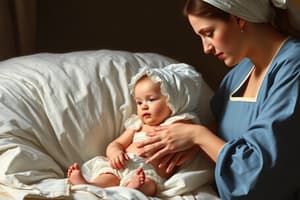Podcast
Questions and Answers
What is the primary characteristic of Pierre Robin Syndrome?
What is the primary characteristic of Pierre Robin Syndrome?
- Tracheoesophageal atresia and fistula
- Cleft palate and tracheoesophageal fistula
- Glossoptosis and esophageal atresia
- Micrognathia, cleft palate, and glossoptosis (correct)
What is the name of the apparatus used to shape the nostril in fetal surgery?
What is the name of the apparatus used to shape the nostril in fetal surgery?
- Esophageal stent
- Tracheal dilator
- Nasal mold apparatus (correct)
- Cleft palate separator
What is the term for an abnormal or surgically made passage between a hollow or tubular organ and the body surface?
What is the term for an abnormal or surgically made passage between a hollow or tubular organ and the body surface?
- Atresia
- Stenosis
- Dysplasia
- Fistula (correct)
What is the term for the obstruction of the esophagus?
What is the term for the obstruction of the esophagus?
What is the term for a small mandible?
What is the term for a small mandible?
What is the percentage of esophageal atresia cases associated with other mesoderm defects?
What is the percentage of esophageal atresia cases associated with other mesoderm defects?
What is the primary difference between omphalocele and gastroschisis?
What is the primary difference between omphalocele and gastroschisis?
What is the name of the association between esophageal atresia and other mesoderm defects?
What is the name of the association between esophageal atresia and other mesoderm defects?
What is the typical location of the defect in gastroschisis?
What is the typical location of the defect in gastroschisis?
What is a common clinical feature of type B esophageal atresia?
What is a common clinical feature of type B esophageal atresia?
What is the percentage of type D esophageal atresia cases?
What is the percentage of type D esophageal atresia cases?
What is the primary management approach for ankyloglossia?
What is the primary management approach for ankyloglossia?
When does the palate process typically close during fetal development?
When does the palate process typically close during fetal development?
What is the common incidence pattern of neurodevelopmental disorders in different populations?
What is the common incidence pattern of neurodevelopmental disorders in different populations?
What is the potential cause of cleft lip and palate?
What is the potential cause of cleft lip and palate?
What should be assessed in children with cleft palate?
What should be assessed in children with cleft palate?
What is the characteristic of cleft lip?
What is the characteristic of cleft lip?
Flashcards are hidden until you start studying
Study Notes
Fetal Surgery and Pierre Robin Syndrome
- Fetal surgery can be performed in utero between 2-10 weeks to repair nasal mold apparatus to shape better nostrils.
- Pierre Robin syndrome is a triad of micrognathia (small mandible), cleft palate, and glossoptosis (tongue malpositioned downward).
Tracheoesophageal Atresia and Fistula
- Tracheoesophageal atresia is an orifice or passage in the body that is closed or absent.
- Fistula is an abnormal or surgically made passage between a hollow or tubular organ and the body surface, or between two hollow or tubular organs.
- Esophageal atresia is an obstruction of the esophagus.
Esophageal Atresia Classification
- Type D: 1% Proximal and distal fistulas (“Double Fistula”)
- Type E: 4% No atresia of the esophagus
VACTERL Association
- Vertebral anomaly
- Anal atresia
- Cardiac anomaly
- Tracheoesophageal fistula
- Esophageal atresia
- Renal anomaly
- Limb malformation
- About 50% of cases are associated with other mesoderm defects.
Clinical Features
- Coughing spells (saliva overflows from the esophagus into the trachea)
- Rales
- Cyanotic attacks
Omphalocele and Gastroschisis
- Omphalocele: a central defect through the umbilical ring, covered by a thin membrane (can be ruptured), with intestines, liver, and other organs outside the abdomen in a sac.
- Gastroschisis: a lateral defect to the right of the umbilicus, no covering membrane (can have fibrous matter), with intestines outside the abdomen through a hole.
Commonly Affected Systems
- Skeletal system
- Gastrointestinal system
- Nervous system
- Physical and developmental challenges
Ankyloglossia (Tongue Tied)
- Abnormal restriction of tongue by an abnormally tight frenulum
- The only management is surgery.
Cleft Palate and Lip
- Failure of the maxillary and median nasal processes to fuse
- Can range from a small notch in the upper lip to total separation of lip and facial structure
- Can be unilateral or bilateral
- More common in boys
- The palate process closes at 9th-12th week of intrauterine life
- Usually occurs in conjunction with cleft lip.
Studying That Suits You
Use AI to generate personalized quizzes and flashcards to suit your learning preferences.




